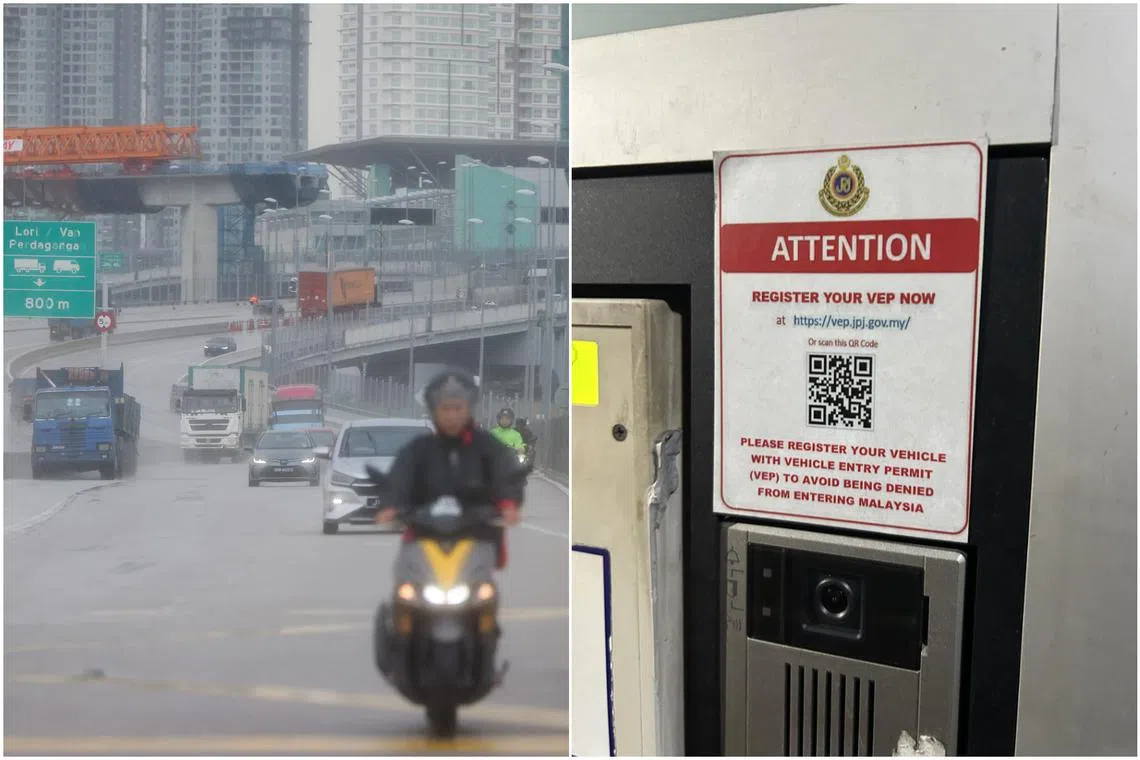We drove into JB on the first day of Malaysia’s VEP roll-out. Here’s what we experienced
Sign up now: Get ST's newsletters delivered to your inbox

ST’s experience mirrored the smoother-than-usual traffic reported by some checkpoint traffic monitoring websites.
ST PHOTOS: ONG WEE JIN, LEE NIAN TJOE
JOHOR BAHRU/SINGAPORE – Five minutes was all it took for our group of five to clear immigration at the Johor Bahru checkpoint in our rented Toyota Alphard car on Oct 1 – the first day of the Vehicle Entry Permit (VEP) scheme for foreign-registered vehicles entering Malaysia.
The Straits Times’ experience mirrored the smoother-than-usual traffic
From Oct 1, foreign-registered vehicles should have a valid VEP to drive into Malaysia. They also need to have a radio frequency identification (RFID) tag.
The system is meant to allow the Malaysian authorities to identify foreign-registered vehicles. The RFID tag, which is affixed to either the windscreen or headlight, can also be used to pay for road tolls.
On Sept 27, the Malaysian authorities announced that enforcement will begin in stages from Oct 1.
As the ST team entered the Bangunan Sultan Iskandar Customs, Immigration and Quarantine Complex in Johor Bahru just before 9am on Oct 1, we noticed a large sign at the start of the lane urging motorists to apply for their VEP. A smaller sign with the same advisory message was affixed next to the window of the immigration counter.
To be clear, I was at the wheel and ready with proof that our seven-seater rental car complied with the new rule.
The company that rented out the Toyota vehicle gave me a printout of the VEP application confirmation slip. I volunteered to show the printout to the immigration officer at the counter, who gave it a cursory glance.
The slip contains the details of the vehicle and its owner. At present, rental cars are not required to have the VEP RFID tag.
According to an e-mail from Malaysia’s Road Transport Department (JPJ) to the Vehicle Rental Association in Singapore in July, rental vehicles need only have the VEP application confirmation slip to enter Malaysia.
This could be why our rental car was not flagged by the system at the Johor checkpoint as not having the RFID tag.
After paying the RM20 (S$6.20) road charge with my Touch ’n Go card by tapping the sensor at the counter, the gantry lifted, and we were free to proceed.
In a Facebook post, JPJ Johor said it had issued reminders to vehicle owners from Singapore who had not registered for the VEP to do so. A photo is attached to the post showing a car at the immigration counter, where the digital display showed “VEP not registered. Please register now”.
Drivers of Singapore-registered cars whom ST spoke to at a petrol station near the Johor Bahru checkpoint, as well as those at the VEP RFID collection centre at Danga Bay in Johor Bahru, said it was a breeze going into Malaysia on Oct 1.
One Singaporean, Mr Albert Tai, 69, who frequents Johor weekly, said that it normally takes about an hour to clear immigration at the checkpoint on a typical weekday. He was at the Danga Bay collection centre to get his RFID tag fixed.
Another Singaporean motorist, Mr Wong, 69, who is retired from the shipyard industry, said: “I think Singaporeans are afraid they might get a warning if they come into Malaysia without the VEP fixed.”
When the ST team reached the Johor checkpoint at 2pm en route back to Singapore, there was no sign of checks or reminders for motorists to complete their VEP application.


